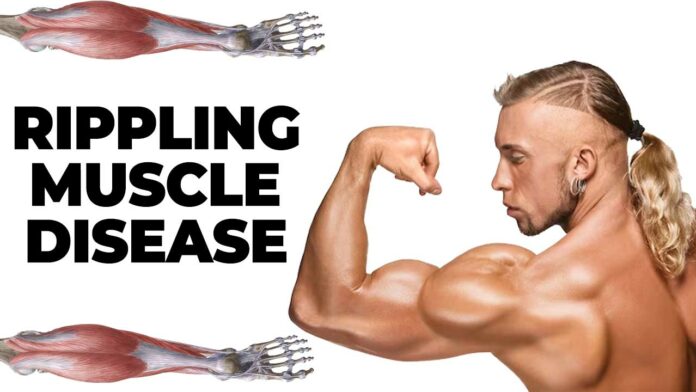Introduction to Rippling Muscle Disease
Firstly, Rippling Muscle Disease (RMD) is a rare neuromuscular disorder characterized by abnormal muscle contractions, often triggered by movement or muscle percussion. Additionally, it falls under the umbrella of congenital myopathies, which are genetic conditions affecting muscle structure and function. Moreover, while relatively uncommon, RMD can have a significant impact on an individual’s quality of life due to its effects o mobility and muscle function.
Understanding the Causes
Genetic Mutation
Myotonia
Myotonia, characterized by delayed relaxation of muscles after contraction, is often associated with RMD. While similar in some ways, the muscle contractions seen in Rippling Muscle Disease (RMD) are distinct from typical myotonia.
Inheritance Patterns
RMD is inherited in an autosomal dominant pattern, meaning that a mutation in one copy of the CAV3 gene is sufficient to cause the disorder. However, the severity and presentation of RMD can vary widely among individuals, even within the same family.
Symptoms and Signs
Muscle Twitching
One of the hallmark symptoms of RMD is muscle twitching or rippling, which occurs when muscles contract spontaneously in response to certain stimuli. These involuntary contractions can be visible under the skin and often occur in a wave-like pattern, giving rise to the name “rippling muscle disease.”
Muscle Weakness
In addition to muscle twitching, individuals with RMD may experience muscle weakness, especially after prolonged activity or exercise. This weakness can affect mobility and lead to fatigue, making everyday tasks more challenging.
Exercise-Induced Phenomenon
Physical activity often worsens the symptoms of RMD, causing muscle twitching and weakness to become more pronounced during or after exercise. This phenomenon induced by exercise can further limit an individual’s ability to participate in physical activities and may require modifications to their exercise routine.
Hypercontractility
Hypercontractility, or increased muscle tone, is another characteristic feature of Rippling Muscle Disease (RMD). This can manifest as stiffness or rigidity in affected muscles, making movement more difficult and contributing to mobility difficulties.
Diagnosis
Diagnosing RMD can be challenging due to its rarity and variable presentation. However, several tests may be used to confirm the diagnosis:
Electromyography (EMG)
EMG is a diagnostic procedure that measures the electrical activity of muscles. In individuals with RMD, EMG may reveal abnormal muscle responses to stimulation, such as repetitive discharges or myotonic discharges.
Muscle Biopsy
A muscle biopsy involves removing a small sample of muscle tissue for examination under a microscope. In RMD, muscle biopsies may show characteristic changes, such as fiber hypertrophy or abnormal staining patterns, which can help support the diagnosis.
Genetic Testing
Genetic testing can identify mutations in the CAV3 gene associated with RMD. This can help confirm the diagnosis and provide valuable information for family members who may be at risk of inheriting the disorder.
Treatment Options
While there is currently no cure for RMD, various treatment options are available to manage symptoms and improve quality of life:
Medications
Medications such as muscle relaxants or anti-myotonic drugs may help alleviate muscle twitching and stiffness in some individuals with RMD. However, the effectiveness of these medications can vary, and they may not be suitable for everyone.
Physical Therapy
Physical therapy can help improve muscle strength, flexibility, and coordination, allowing individuals with RMD to better manage their symptoms and maintain mobility. A tailored exercise program can target specific muscle groups and address functional limitations.
Lifestyle Modifications
Making certain lifestyle modifications, such as avoiding strenuous exercise or minimizing exposure to triggers, can help reduce the frequency and severity of muscle twitching episodes in individuals with RMD. Stress management techniques, relaxation exercises, and adequate rest can also play a role in symptom management.
Surgical Interventions
In severe cases of Rippling Muscle Disease (RMD) where symptoms are debilitating and refractory to other treatments, surgical interventions such as myotomy (surgical cutting of muscle fibers) may be considered to alleviate muscle stiffness and improve function. However, surgery carries risks and is usually reserved for cases where conservative measures have failed.
Living with Rippling Muscle Disease
Living with RMD can be challenging, but there are several coping strategies that individuals can employ to manage their symptoms and improve their quality of life:
Coping Strategies
Finding effective coping strategies is essential for individuals with RMD to navigate daily challenges and maintain a positive outlook. This may include seeking support from healthcare professionals, joining support groups or online communities, practicing stress management techniques, and engaging in activities that bring joy and fulfillment.
Support Systems
Quality of Life
Despite the challenges posed by RMD, many individuals are able to lead fulfilling lives with appropriate management and support. Focusing on activities and hobbies that bring joy, maintaining social connections, and staying informed about new developments in RMD research and treatment can all contribute to a higher quality of life.
Research and Developments
Research into potential treatments for RMD is ongoing, with several promising therapies in development:
Emerging Therapies
Clinical Trials
Participating in clinical trials can provide individuals with RMD access to cutting-edge treatments and contribute to advancing our understanding of the disorder. Interested individuals can speak with their healthcare providers or visit clinical trial registries to learn more about ongoing trials and eligibility criteria.
Conclusion
In conclusion, Rippling Muscle Disease is a rare neuromuscular disorder characterized by unique muscle contractions and associated symptoms. Additionally, while there is currently no cure for RMD, various treatment options and coping strategies can help individuals manage symptoms and maintain functional independence. Moreover, with ongoing research and advancements in the field, there is hope for improved understanding, diagnosis, and management of RMD in the future.
FAQs about Rippling Muscle Disease
1. What causes rippling muscle disease?
RMD is primarily caused by mutations in the CAV3 gene, which disrupt normal muscle function and lead to characteristic symptoms such as muscle twitching and weakness.
2. How is rippling muscle disease diagnosed?
Diagnosing Rippling Muscle Disease (RMD) typically involves a combination of clinical evaluation, electromyography (EMG), muscle biopsy, and genetic testing to confirm the presence of characteristic features and identify underlying genetic mutations.
3. Can rippling muscle disease be cured?
There is currently no cure for RMD, but various treatment options are available to manage symptoms and improve quality of life. These may include medications, physical therapy, lifestyle modifications, and in some cases, surgical interventions.
4. What lifestyle changes can help manage rippling muscle disease?
Making lifestyle modifications such as avoiding strenuous exercise, minimizing exposure to triggers, and practicing stress management techniques can help reduce the frequency and severity of symptoms in individuals with RMD.
5. Are there any promising treatments on the horizon?
Research into potential treatments for RMD is ongoing, with several emerging therapies showing promise in preclinical and clinical studies. These may include gene therapy approaches and novel pharmacological agents targeting specific pathways involved in muscle function.

